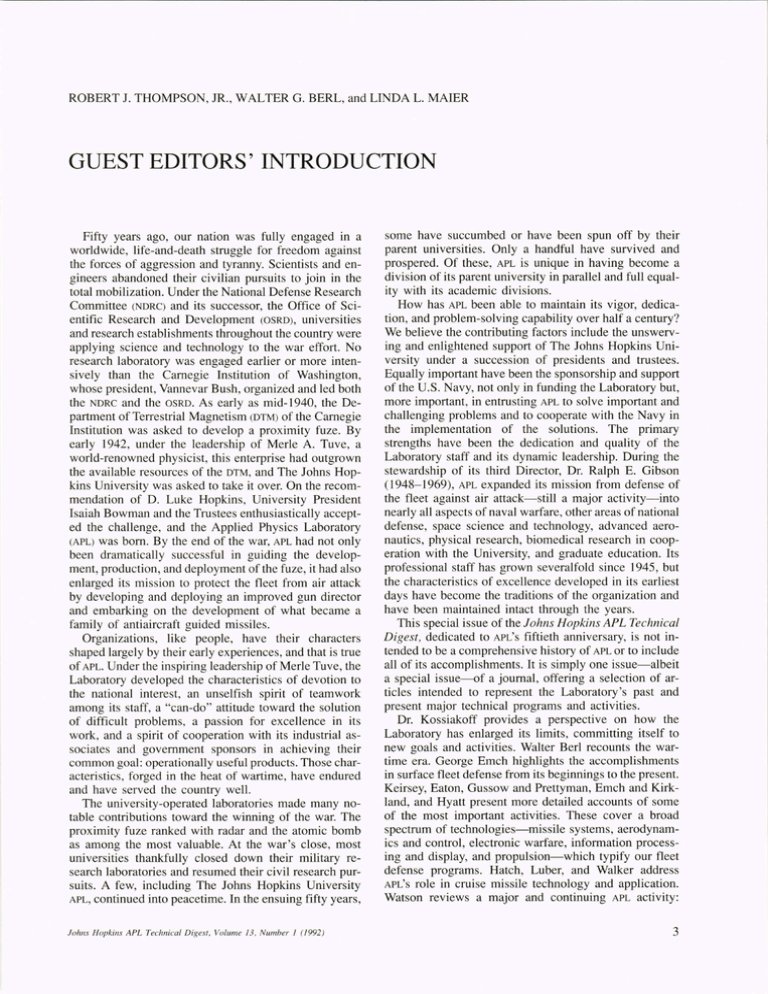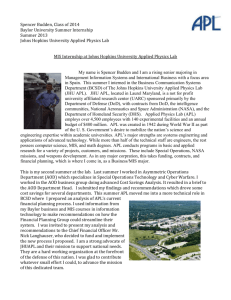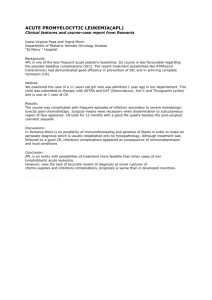GUEST EDITORS' INTRODUCTION
advertisement

ROBERT J. THOMPSON, JR., WALTER G. BERL, and LINDA L. MAIER GUEST EDITORS' INTRODUCTION Fifty years ago, our nation was fully engaged in a worldwide, life-and-death struggle for freedom against the forces of aggression and tyranny. Scientists and engineers abandoned their civilian pursuits to join in the total mobilization. Under the National Defense Research Committee (NDRC) and its successor, the Office of Scientific Research and Development (OSRD), universities and research establishments throughout the country were applying science and technology to the war effort. No research laboratory was engaged earlier or more intensively than the Carnegie Institution of Washington, whose president, Vannevar Bush, organized and led both the NDRC and the OSRD. As early as mid-1940, the Department of Terrestrial Magnetism (DTM) of the Carnegie Institution was asked to develop a proximity fuze. By early 1942, under the leadership of Merle A. Tuve, a world-renowned physicist, this enterprise had outgrown the available resources of the DTM, and The Johns Hopkins University was asked to take it over. On the recommendation of D. Luke Hopkins, University President Isaiah Bowman and the Trustees enthusiastically accepted the challenge, and the Applied Physics Laboratory (APL) was born. By the end of the war, APL had not only been dramatically successful in guiding the development, production , and deployment of the fuze, it had also enlarged its mission to protect the fleet from air attack by developing and deploying an improved gun director and embarking on the development of what became a family of antiaircraft guided missiles. Organizations, like people, have their characters shaped largely by their early experiences, and that is true of APL. Under the inspiring leadership of Merle Tuve, the Laboratory developed the characteristics of devotion to the national interest, an unselfish spirit of teamwork among its staff, a "can-do" attitude toward the solution of difficult problems, a passion for excellence in its work, and a spirit of cooperation with its industrial associates and government sponsors in achieving their common goal: operationally useful products. Those characteristics, forged in the heat of wartime, have endured and have served the country well. The university-operated laboratories made many notable contributions toward the winning of the war. The proximity fuze ranked with radar and the atomic bomb as among the most valuable. At the war's close, most universities thankfully closed down their military research laboratories and resumed their civil research pursuits. A few, including The Johns Hopkins University APL, continued into peacetime. In the ensuing fifty years, f ohns Hopkins APL Technical Digest, Volume 13, Number 1 (1992 ) some have succumbed or have been spun off by their parent universities. Only a handful have survived and prospered. Of these, APL is unique in having become a division of its parent university in parallel and full equality with its academic divisions. How has APL been able to maintain its vigor, dedication, and problem-solving capability over half a century? We believe the contributing factors include the unswerving and enlightened support of The Johns Hopkins University under a succession of presidents and trustees. Equally important have been the sponsorship and support of the U.S. Navy, not only in funding the Laboratory but, more important, in entrusting APL to solve important and challenging problems and to cooperate with the Navy in the implementation of the solutions. The primary strengths have been the dedication and quality of the Laboratory staff and its dynamic leadership. During the stewardship of its third Director, Dr. Ralph E. Gibson (1948- 1969), APL expanded its mission from defense of the fleet against air attack-still a major activity-into nearly all aspects of naval warfare, other areas of national defense, space science and technology, advanced aeronautics, physical research, biomedical research in cooperation with the University, and graduate education. Its professional staff has grown severalfold since 1945, but the characteristics of excellence developed in its earliest days have become the traditions of the organization and have been maintained intact through the years. This special issue of the fohns Hopkins APL Technical Digest, dedicated to APL'S fiftieth anniversary, is not intended to be a comprehensive history of APL or to include all of its accomplishments. It is simply one issue-albeit a special issue--of a journal, offering a selection of articles intended to represent the Laboratory's past and present major technical programs and activities. Dr. Kossiakoff provides a perspective on how the Laboratory has enlarged its limits, committing itself to new goals and activities. Walter Berl recounts the wartime era. George Emch highlights the accomplishments in surface fleet defense from its beginnings to the present. Keirsey, Eaton, Gussow and Prettyman, Emch and Kirkland, and Hyatt present more detailed accounts of some of the most important activities. These cover a broad spectrum of technologies-missile systems, aerodynamics and control, electronic warfare, information processing and display, and propulsion-which typify our fleet defense programs. Hatch, Luber, and Walker address APL'S role in cruise missile technology and application. Watson reviews a major and continuing APL activity: 3 support of the fleet ballistic missile program. The articles by Holmboe and Seymour and by Tyler address some aspects of our activities in support of the security of the submarine forces . Hunt presents the problems, failures, and successes of analytical approaches to understanding and predicting the military environment. One of APL'S foremost achievements, the Transit satellite navigation system, grew out of our mission in support of the fleet ballistic missile. The resultant APL space program is notable for its many inventions and innovations, as recounted by Hoffman. Potemra reviews more than forty-five years of research in plasma phenomena, one major APL contribution to space science. The Laboratory's expertise in space technology and system engineering and in leading cooperative efforts has positioned it to make a unique and valuable contribution to the Strategic Defense Initiative, discussed in the article by Coughlin et al. White presents the National AeroSpace Plane program, an outgrowth of forty-five years of propulsion research at APL. In nonmilitary programs, Fischell and the article by Kues and Monahan present two of many APL contributions to biomedicine: the development of implantable devices for patient treatment, and research on microwave radiation damage to the eye. Kistenmacher, Cowan, and Poehler present some results of years of cooperative basic research between APL and the Homewood campus, in this case, organic materials with high electrical conductivity, an area of both theoretical and practical interest. Kohlenstein, Portner, Burton, and Reilly review some of APL'S contributions to the understanding of environmental pollution problems. Let us emphasize again that these articles are only a selective representation of the Laboratory's work. A different selection might equally well be made. Similarly, while some contributors have been named, we recognize that hundreds of other worthy contributors have remained unnamed. Although the articles and the accomplishments reported herein are diverse, common threads run through many of them. The Laboratory 's principal forte has been the solving of important and difficult real-world problems. Many of these have required application of the principles of system engineering. Over the years, APL has become increasingly information oriented, so that a major portion of its work now involves the sensing, processing, display, and interpretation of information. What of the future? The collapse of the Warsaw Pact and then of the Soviet Union itself has dramatically changed the threat to freedom and democracy and the defense posture of the United States. But the end of the Cold War does not presage the beginning of the millennium or even the emergence of a safe world. There will be challenges in maintaining, on a greatly diminished budget, an effective defense that can quickly respond to threats worldwide. A host of domestic problems also could benefit from APL'S problem-solving, system-oriented approach. With its combination of technical capability and dedication to public service, APL is well positioned to continue to contribute to the national well-being. 4 THE AUTHORS ROBERT J. THOMPSON, Jr. (left) was born in San Francisco and graduated from UCLA. During World War II, he conducted research on rockets at Allegany Ballistics Laboratory . He subsequently completed his Ph.D. in physical chemistry at the University of Rochester. Dr. Thompson carried out research and engineering of rocket propulsion systems at the MW Kellogg Co., Bendix Aviation, and Rockwell International , where he served successively as Vice President and Research Director of the Rocketdyne Division and Vice President and General Manager of the Solid Rocket Division. He joined APL in 1974 as Assistant to the Director, later served as supervisor of the Technical Information Branch, and is now on the staff of the Technical Services Department. Dr. Thompson has been active in both the Technical Management Program and the Johns Hopkins APL Technical Digest since their inception. WALTER G. BERL (right) joined APL in 1945 and is a member of the Principal Professional Staff. In 1937, he received a B.S. degree in chemical engineering from the Carnegie Institute of Technology, followed by an M .S. from Harvard in 1939 and a Ph.D. from Carnegie in 1941 in physical chemistry. After a di stinguished career in combustion and fire research and their applications to practice, he was Editor-in-Chief of the Johns Hopkins APL Technical Digest (198087) and the APL Technical Review (1988-89). A member of numerous professional societies and advi sory boards, he is the author of more than forty technical papers. He was recently the William F. Parsons Professor at the Paul H. Nitze School of Advanced International Studies of The Johns Hopkins University , where he was involved with the introduction of an expanded curriculum in the role of sc ience and technology in international affairs. LINDA L. MAIER received her B.A. in English from the University of Maryland. She is Assistant to the Editor-in-Chief of the Johns Hopkins APL Technical Digest; in that role she also assists in administering the annual publication awards program recognizing outstanding publications by APL staff members. Ms. Maier is serving as an advisor on the Ad Hoc Subcommittee for the "Hi story of Women at APL" exhibit commemorating APL's fiftieth anniversary and is a Steering Committee member of The Johns Hopkins University Women 's Forum . She is a member of the Society for Scholarly Publishing and the American Medical Writers Association. Johns Hopkins APL Technical Digest, Vo lum e 13, Number I (1992)



